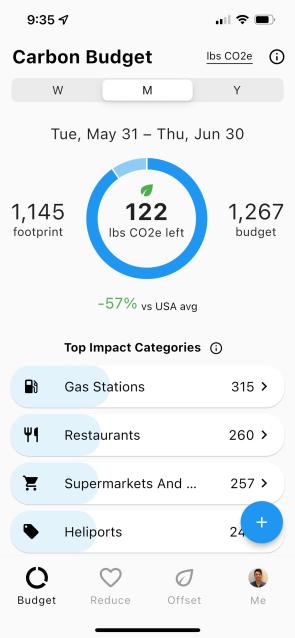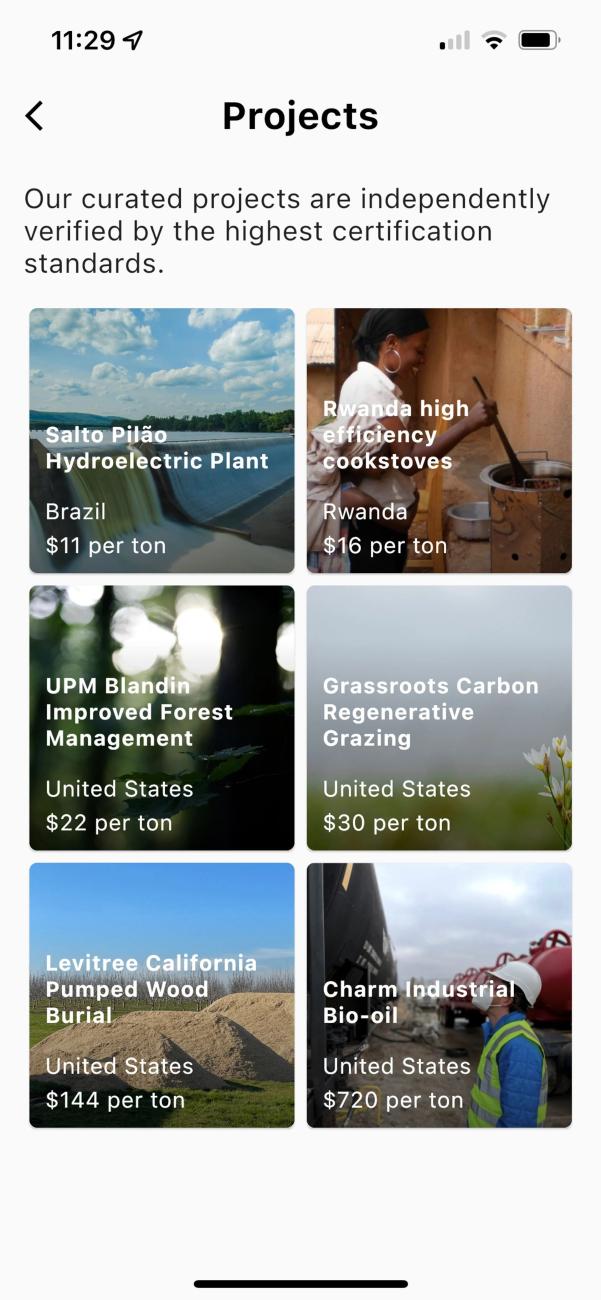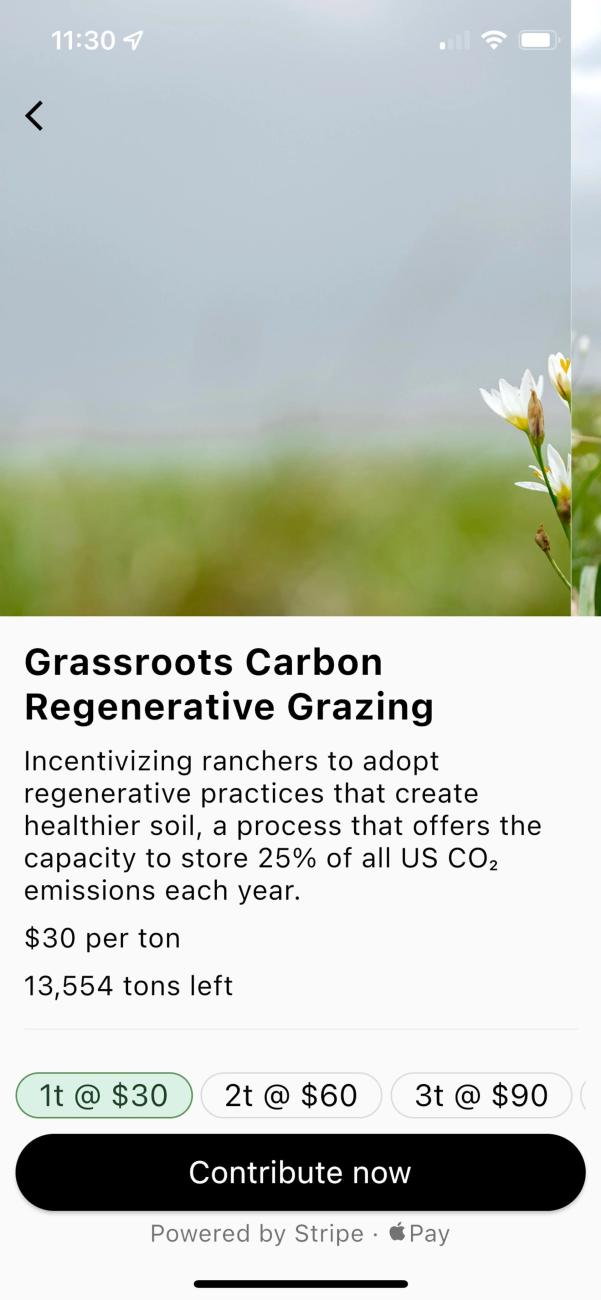
There’s an app for everything these days—from calculating how high you can throw your phone to a “hand cooler” (it just emits the sound of a fan)—but what about a free and easy-to-use app that’s actually useful and calculates the carbon footprint of your purchases while offering tangible solutions? Meet Decarbon, co-founder Kyle Graycar’s solution to help people feel empowered about climate change.
Decarbon, a certified green business, has a simple set-up: Connect your bank account using the trusted third-party integrator Plaid (used in similar apps like Venmo). The app then categorizes all your transactions and assigns them carbon footprints, providing you with insights and recommendations to lower your footprint based on your purchases.
Monitoring transactions is a good way to track your carbon footprint and vote with your dollar, but equally important is where you bank. Mega-banks are some of the biggest funders of fossil fuels and the rapidly evolving climate crisis, so break up with your mega-bank and then sign up for Decarbon.
Graycar understands reservations about providing bank account info, recalling when the app first began: “These very valid questions came in: ‘Is this a scam? How do I trust this tiny startup with my data?’”
Plus, how does the app calculate carbon footprints and are the solutions truly actionable? We’ve got all the answers on your latest app obsession.
There’s No Secrecy Here, Only Transparency
Both the app and Plaid are trustworthy and secure, with access only to basic transaction information, but Decarbon also offers alternative ways to calculate your footprint, like a monthly estimate based on a questionnaire or the ability to manually put in transactions.
Transparency is the pillar of Decarbon, as evidenced by its open-source database. Every number, every calculation has an explanation.
In the app, users need only investigate the Budget section to see the exact calculations Decarbon utilized to determine the emissions estimate for each transaction. Plus, users can also modify every transaction to make it more accurate.

“We use publicly available scientific and governmental sources,” Graycar says, all of which is outlined both in the app and on the website. “Being open source, we hope to eventually gather a community of contributors who can help us expand and deepen the accuracy of our calculations.”
The actual calculation is simple multiplication: dollar amount x emissions factor for that transaction category. If the purchase has a modifier, like diet (vegetarian, vegan, etc.) or renewable energy used in a utility bill, that is also considered.
Like any piece of technology, changes are expected and Graycar embraces them.
The Decarbon website also offers an extensive guide to help you both understand the app better and various climate topics.
Education → Action
What good is knowing your carbon footprint, however, without solutions? That’s why Decarbon is far more than a simple calculator.
It offers several solutions to aim for a net-neutral life as much as possible, from food habits to alternative places to shop and beyond.
“Some of the actions in the app don't even have to do with your personal carbon footprint, it could be about promoting bike safety in your community to encourage zero carbon transportation,” Graycar explains.
Decarbon also offers carbon offsets for purchases to help towards your net-zero future.
Staying consistent to his commitment to accessibility and intentionality, Graycar notes it is a priority to offer affordable and verified carbon offsets.
“It’s a balance of making the currently offered offsets as rigorous as possible by following certification standards, while also making them as accessible as possible by providing a range of prices,” he says.


Graycar acknowledges other factors in choosing offsets, like location, preferring projects based in the United States, and projects that physically remove carbon from the atmosphere.
Ultimately, however, while the app offers this option, Graycar knows offsets alone won’t solve the climate crisis.
“It's so much more important to take steps to reduce your own emissions by completing climate actions and to inspire your peers to reduce their emissions with you,” he says. “Carbon credits, as Al Gore has put it, need to be a last resort once you've made an effort to lower your footprint.”
Most Importantly, It’s Free and Communal
Since Decarbon launched in 2020, and during its development years, Graycar has been intentional about how it operates. The first and most obvious benefit is that the app is free, which Graycar describes as an “accessibility thing.” To achieve collective action, mass participation is required, and the first barrier is cost.
There is also a community element to the app, where users can discuss different sustainable solutions, offer personal tips, and learn from each other.
Collabs are another feature of the app—mini podcasts showcasing a different thought leader in the climate space each month.
It’s also a way, Graycar hopes, for people to feel less alone and discouraged while doing this work.
“The last thing that we should be feeling is embarrassment or shame,” he says. "You're showing up and putting intention into your footprint—that's incredible. The people most responsible for the climate crisis, corporations and governments, should be taking these steps, of course, but as individuals if we act collectively, we can really make a difference.”
Inspiringly, Graycar says, users have started using Decarbon towards goals he never imagined.
“I spoke with a user who lives in rural Colorado,” he explains. “He was stoked about the app and plans to use it to engage his county government in taking climate action and introducing legislation. It’s a use for Decarbon I never considered.”
Collective action at work, indeed.

